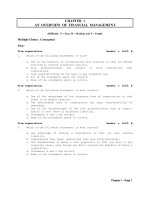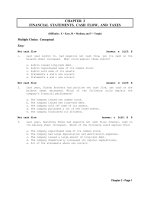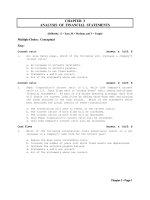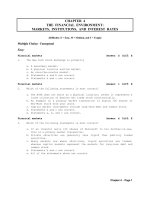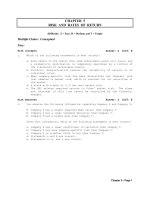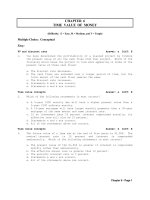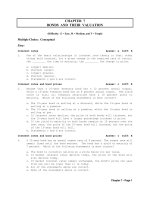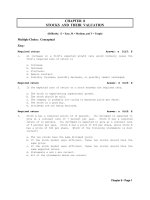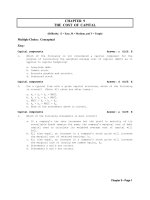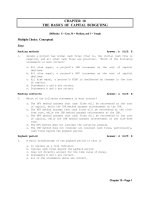Test bank Finance Management chapter 14 distributions to shareholders dividends and share repurchases
Bạn đang xem bản rút gọn của tài liệu. Xem và tải ngay bản đầy đủ của tài liệu tại đây (240.51 KB, 27 trang )
CHAPTER 14
DISTRIBUTIONS TO SHAREHOLDERS:
DIVIDENDS AND SHARE REPURCHASES
(Difficulty: E = Easy, M = Medium, and T = Tough)
Multiple Choice: Conceptual
Easy:
Dividends versus capital gains
1.
Answer: d
Diff: E
Myron Gordon and John Lintner believe that the required return on equity
increases as the dividend payout ratio is decreased.
Their argument is
based on the assumption that
a. Investors are indifferent between dividends and capital gains.
b. Investors require that the dividend yield and capital gains yield equal
a constant.
c. Capital gains are taxed at a higher rate than dividends.
d. Investors view dividends as being less risky than potential future
capital gains.
e. Investors value a dollar of expected capital gains more highly than a
dollar of expected dividends because of the lower tax rate on capital
gains.
Dividends, DRIPs, and repurchases
2.
Answer: d
Diff: E
Which of the following statements is most correct?
a. In general, stock repurchases are taxed the same way as dividends.
b. One nice feature of dividend reinvestment plans is that they enable
investors to reduce the taxes paid on their dividends.
c. On average, companies send a negative signal to the marketplace when
they announce an increase in their dividend.
d. If a company is interested in issuing new equity capital, a new stock
dividend reinvestment plan probably makes more sense than an open
market dividend reinvestment plan.
e. Statements b and d are correct.
Dividend payout
3.
Answer: a
Diff: E
In the real world, we find that dividends
a.
b.
c.
d.
e.
Usually exhibit greater stability than earnings.
Fluctuate more widely than earnings.
Tend to be a lower percentage of earnings for mature firms.
Are usually changed every year to reflect earnings changes.
Are usually set as a fixed percentage of earnings.
Chapter 14 - Page 1
Dividend payout
4.
Diff: E
A decrease in a firm’s willingness to pay dividends is likely to result
from an increase in its
a.
b.
c.
d.
e.
Earnings stability.
Access to capital markets.
Profitable investment opportunities.
Collection of accounts receivable.
Stock price.
Dividend theories
5.
Answer: c
Answer: e
Diff: E
Which of the following statements best describes the theories of investors’
preferences for dividends?
a. Modigliani and Miller argue that investors prefer dividends to capital
gains.
b. The bird-in-hand theory suggests that a company can reduce its cost of
equity capital by reducing its dividend payout ratio.
c. The tax preference theory suggests that a company can increase its
stock price by increasing its dividend payout ratio.
d. One key advantage of a residual dividend policy is that it enables a
company to follow a stable dividend policy.
e. The clientele effect suggests that companies should follow a stable
dividend policy.
Dividend theory and policy
6.
Answer: c
Diff: E
Which of the following statements is most correct?
a. The bird-in-the-hand theory implies that a company can reduce its WACC
by reducing its dividend payout.
b. The bird-in-the-hand theory implies that a company can increase its
stock price by reducing its dividend payout.
c. One problem with following a residual dividend policy is that it can
lead to erratic dividend payouts that may prevent the firm from
establishing a reliable clientele of investors who prefer a particular
dividend policy.
d. Statements a and c are correct.
e. All of the statements above are correct.
Optimal dividend policy
7.
Answer: e
Diff: E
Which of the following would not have an influence on the optimal dividend
policy?
a. The possibility of accelerating or delaying investment projects.
b. A strong shareholders’ preference for current income versus capital
gains.
c. Bond indenture constraints.
d. The costs associated with selling new common stock.
e. All of the statements above can have an effect on dividend policy.
Chapter 14 - Page 2
Residual dividend policy
8.
Answer: a
Diff: E
Trenton Publishing follows a strict residual dividend policy.
All else
being equal, which of the following factors are likely to cause an increase
in the firm’s per-share dividend?
a. An increase in its net income.
b. The company increases the proportion of equity financing in its target
capital structure.
c. An increase in the number of profitable projects that it wants to fund
this year.
d. Statements a and b are correct.
e. All of the statements above are correct.
Stock split
9.
Diff: E
A stock split will cause a change in the total dollar amounts shown in
which of the following balance sheet accounts?
a.
b.
c.
d.
e.
Cash.
Common stock.
Paid-in capital.
Retained earnings.
None of the statements above is correct.
Stock split
10.
Answer: e
Answer: b
Diff: E
You currently own 100 shares of stock in Beverly Brothers Inc. The stock
currently trades at $120 a share. The company is contemplating a 2-for-1
stock split. Which of the following best describes your position after the
proposed stock split takes place?
a. You will have
$120 a share.
b. You will have
$60 a share.
c. You will have
$60 a share.
d. You will have
$120 a share.
e. You will have
$60 a share.
200 shares of stock, and the stock will trade at or near
200 shares of stock, and the stock will trade at or near
100 shares of stock, and the stock will trade at or near
50 shares of stock, and the stock will trade at or near
50 shares of stock, and the stock will trade at or near
Chapter 14 - Page 3
Stock repurchases and DRIPs
11.
Answer: a
Diff: E
Which of the following statements is most correct?
a. One advantage of stock repurchases is that they are generally taxed
more favorably than dividend payments.
b. One advantage of dividend reinvestment plans is that they enable
investors to avoid paying taxes on the dividends they receive.
c. Stock repurchases make sense if a company is interested in increasing
its equity ratio.
d. Stock repurchases make sense if a company believes that its stock is
overvalued and that it has a lot of profitable projects to fund over
the next year.
e. One advantage of an open market dividend reinvestment plan is that it
increases the number of shares the company has outstanding.
Repurchases, DRIPs, and stock splits
12.
Answer: e
Diff: E
Which of the following statements is most correct?
a. One reason that companies tend to avoid stock repurchases is that
dividend payments are taxed more favorably than stock repurchases.
b. One advantage of dividend reinvestment plans is that they allow
shareholders to avoid paying taxes on the dividends that they choose to
reinvest.
c. If a company announces a 2-for-1 stock split and the overall value of
the firm remains unchanged, the company’s stock price must have
doubled.
d. All of the statements above are correct.
e. None of the statements above is correct.
Dividend policy and stock repurchases
13.
Answer: d
Diff: E
N
Which of the following statements is most correct?
a. The tax code encourages companies to pay dividends.
b. If a company uses the residual dividend model to determine its dividend
payout ratio, its dividend payout will tend to increase whenever it has
a large number of investment opportunities.
c. The clientele effect encourages companies to adopt a strict version of
the residual dividend model.
d. In many cases, stock repurchases tend to increase earnings per share,
but they also increase the firm’s debt ratio and financial risk.
e. Stock repurchases are taxed the same way as dividends are taxed.
Chapter 14 - Page 4
Miscellaneous dividend concepts
14.
Answer: c
Diff: E
Which of the following statements is most correct?
a. If a company puts in place a 2-for-1 stock split, its stock price
should roughly double.
b. Share repurchases are taxed less favorably than dividends; this
explains why companies typically pay dividends and avoid share
repurchases.
c. On average, a company’s stock price tends to rise when it announces
that it is initiating a share repurchase program.
d. Statements a and b are correct.
e. All of the statements above are correct.
Miscellaneous dividend concepts
15.
Answer: e
Diff: E
Which of the following statements is most correct?
a. The bird-in-the-hand theory argues that investors prefer dividends
because dividends are taxed more favorably than capital gains.
b. Stock repurchases increase the number of outstanding shares.
c. The clientele effect can explain why companies tend to vary their
dividends a lot on a year-to-year basis.
d. Statements a and b are correct.
e. None of the statements above is correct.
Miscellaneous dividend concepts
16.
Answer: e
Diff: E
Which of the following statements is most correct?
a. The tax preference hypothesis suggests that companies can reduce their
costs of capital by increasing their dividend payout ratios.
b. One advantage of the residual dividend policy is that it leads to a
stable dividend payout, which is desired by investors.
c. Firms with a large number of investment opportunities and a relatively
small amount of cash tend to have above average dividend payouts.
d. Statements a and b are correct.
e. None of the statements above is correct.
Medium:
Dividend theory
17.
Answer: a
Diff: M
Which of the following statements is most correct?
a. The tax preference theory states that, all else equal, investors prefer
stocks that pay low dividends because retained earnings can lead to
capital gains that are taxed at a lower rate.
b. An increase in the cost of equity capital (ks) when a company announces
an increase in its dividend per share, would be consistent with the
bird-in-the-hand theory.
c. An increase in the stock price when a company decreases its dividend is
consistent with the signaling theory.
d. A dividend policy that involves paying a consistent percentage of net
income is the best policy if the “clientele effect” is correct.
e. Statements a and d are correct.
Chapter 14 - Page 5
Dividend policy
18.
Answer: b
Diff: M
Which of the following statements is most correct?
a. The Tax Code encourages companies to pay large dividends to their
shareholders.
b. If your company has established a clientele of investors who prefer
large dividends, the company is unlikely to adopt a residual dividend
policy.
c. If a firm follows a residual dividend policy, holding all else
constant, its dividend payout will tend to rise whenever the firm’s
investment opportunities improve.
d. Statements b and c are correct.
e. All of the statements above are correct.
Dividend policy
19.
Answer: c
Diff: M
Which of the following statements is most correct?
a. If Congress cuts the capital gains rate, but leaves the personal tax
rate unchanged, then this would provide an incentive for companies to
increase their dividend payouts.
b. Despite its drawbacks, a residual dividend policy is an effective way
to stabilize dividend payouts, which makes it easier for firms to
attract a clientele that prefers high dividends.
c. If a firm follows a residual dividend policy, then a sudden increase in
the number of profitable projects is likely to reduce the firm’s
dividend payout.
d. All of the statements above are correct.
e. None of the statements above is correct.
Dividend policy
20.
Answer: a
Diff: M
Which of the following statements is most correct?
a. The bird-in-the-hand theory would predict that companies could decrease
their cost of equity financing by raising their dividend payout.
b. The clientele effect can explain why firms often change their dividend
policies.
c. One advantage of adopting a residual dividend policy is that it makes
it easier for corporations to maintain dividend clienteles.
d. Statements a and c are correct.
e. None of the statements above is correct.
Residual dividend policy
21.
Answer: c
Diff: M
If a firm adheres strictly to the residual dividend policy, a sale of new
common stock by the company would suggest that
a.
b.
c.
d.
e.
The dividend payout ratio has remained constant.
The dividend payout ratio is increasing.
No dividends were paid for the year.
The dividend payout ratio is decreasing.
The dollar amount of investments has decreased.
Chapter 14 - Page 6
Residual dividend policy
22.
Diff: M
If a firm adheres strictly to the residual dividend policy, then if its
optimal capital budget requires the use of all earnings for that year
(along with new debt according to the optimal debt/total assets ratio), the
firm should pay
a.
b.
c.
d.
e.
No dividends except out of past retained earnings.
No dividends to common stockholders.
Dividends, in effect, out of a new issue of common stock.
Dividends by borrowing the money (debt).
Either statement c or statement d above could be used.
Dividends versus capital gains
23.
Answer: b
Answer: b
Diff: M
Modigliani and Miller (MM) argued that dividend policy is irrelevant.
On the other hand, Gordon and Lintner (GL) argued that dividend policy does
matter. GL’s argument rests on the contention that
a. ks = D1/P0 + g is constant for any dividend policy.
b. Because of perceived differences in risk, investors value a dollar of
dividends more highly than a dollar of expected capital gains.
c. Investors, because of tax differentials, value a dollar of expected
capital gains more highly than a dollar of dividends.
d. Most investors will reinvest rather than spend dividends, so it would
save investors money (taxes) if corporations simply reinvested earnings
rather than paid them out as dividends.
e. None of the statements above is correct.
Taxes, DRIPs, and stock splits
24.
Answer: d
Diff: M
R
Congress passed a new tax law that reduced long-term capital gains tax
rates from 28 percent to 20 percent. The maximum tax rate for ordinary
personal income is 38.6 percent. Which of the following statements is most
correct for an investor in a high personal tax bracket?
a. The stock of a company that pays high cash dividends and has a dividend
reinvestment plan (DRIP) is a good investment for this individual
because he/she will receive more money that can then be reinvested in
the company’s stock.
b. A 2-for-1 stock split is announced for a stock that the investor
currently holds.
The company had split the stock because the stock
price had increased beyond the optimal price range and is expected to
continue to grow. This is good news to the investor because it means
that any gains from increased stock value will be taxed at a new lower
long-term capital gains rate when the stock is sold.
c. One of the companies in the investor’s portfolio recently announced
that it will embark on a stock repurchase plan. The lower long-term
capital gains tax rate will reduce the investor’s taxes if he/she
decides to tender some shares of stock in the company.
d. Statements b and c are correct.
e. All of the statements above are correct.
Chapter 14 - Page 7
Taxes, DRIPs, and dividends
25.
Answer: e
Diff: M
Which of the following statements is most correct?
a. “New-stock” dividend reinvestment plans are similar to stock dividends
because they both increase the number of shares outstanding but don’t
change the total equity of a firm.
b. Investors receiving stock dividends must pay taxes on the new shares at
the time the stock dividends are received.
c. Stockholders pay no income tax on dividends reinvested in a dividend
reinvestment plan.
d. Statements a and b are correct.
e. None of the statements above is correct.
Stock repurchases and stock splits
26.
Answer: e
Diff: M
Which of the following statements is most correct?
a. Stock repurchases can be used by firms to defend against hostile
takeovers since they increase the proportion of debt in a firm’s
capital structure.
b. After a 3-for-1 stock split, a company’s price per share will fall and
its number of shares outstanding will rise.
c. Investors can interpret a stock repurchase by a firm as a signal that
the firm’s managers believe the stock is underpriced.
d. Statements a and b are correct.
e. All of the statements above are correct.
Miscellaneous dividend concepts
27.
Answer: a
Diff: M
Which of the following statements is most correct?
a. Companies can repurchase shares either (1) to change their capital
structures or (2) to distribute cash to stockholders without paying
cash dividends.
In the second situation, tax considerations will
probably play a key role in the decision to repurchase stock versus to
pay more cash dividends.
b. Stock dividends provide investors with additional shares of stock, not
cash, yet many investors must pay cash in the form of taxes on the
value of the stock dividends.
For this reason, stock dividends are
rarely used today.
c. The bird-in-the-hand theory of dividend policy could be rejected
immediately if personal income taxes were abolished.
d. If the curve relating the WACC and the debt ratio looks like a sharp
“V,” this would make it more feasible for a firm to follow the residual
dividend policy than if the curve looks like a shallow bowl (or a
shallow “U”).
e. The open market type of dividend reinvestment plan is the best type for
firms that need to bring in new equity capital.
Chapter 14 - Page 8
Miscellaneous dividend concepts
28.
Answer: e
Diff: M
Which of the following statements is most correct?
a. If a firm repurchases its stock in the open market, the shareholders
that tender are subject to capital gains taxes.
b. If you own 100 shares in a company’s stock, and the company does a
2-for-1 stock split, you will own 200 shares in the company following
the split.
c. Some dividend reinvestment plans increase the amount of equity capital
available to the firm.
d. Statements a and b are correct.
e. All of the statements above are correct.
Miscellaneous dividend concepts
29.
Answer: e
Diff: M
Which of the following statements is most correct?
a. An open-market dividend reinvestment plan is likely to be attractive to
companies that are looking to issue additional shares of common stock.
b. Stock repurchases have the effect of reducing financial leverage.
c. If a company does a 2-for-1 stock split, its stock price will roughly
double.
d. All of the statements above are correct.
e. None of the statements above is correct.
Miscellaneous dividend concepts
30.
Answer: a
Diff: M
Which of the following statements is most correct?
a. If a company wants to issue new shares of common stock and also wants
to implement a dividend reinvestment plan, then it should implement a
new-stock dividend reinvestment plan, rather than an open-market
purchase plan.
b. If a company undertakes a 3-for-1 stock split, then the number of
shares outstanding should fall, and the stock price should rise.
c. If a company wants to reduce its debt ratio, then it should repurchase
some of its common stock.
d. Statements a and c are correct.
e. Statements b and c are correct.
Miscellaneous dividend concepts
31.
Answer: d
Diff: M
Which of the following statements is most correct?
a. If you were testing dividend theories and found that a dividend
increase resulted in higher stock prices, then you could rule out all
other theories and conclude that the bird-in-the-hand theory was most
consistent with the evidence you found.
b. The clientele effect suggests that investors choose their investments
based on firms’ past dividend policies and changes to established
dividend policies may be costly to investors.
c. Dividends paid under a residual dividend policy might send conflicting
signals to investors.
d. Statements b and c are correct.
e. All of the statements above are correct.
Chapter 14 - Page 9
Miscellaneous dividend concepts
32.
Diff: M
Which of the following actions will enable a company to raise additional
equity capital (that is, which of the following will raise the total book
value of equity)?
a.
b.
c.
d.
e.
The establishment of a new-stock dividend reinvestment plan.
A stock split.
The establishment of an open-market purchase dividend reinvestment plan.
A stock repurchase.
Statements a and d are correct.
Miscellaneous concepts
33.
Answer: a
Answer: b
Diff: M
Firm M is a mature firm in a mature industry. Its annual net income and
net cash flow are both consistently high and very stable. The company’s
growth prospects are quite limited; therefore, the company’s capital budget
is small relative to its net income. Firm N is a relatively new firm in a
new industry. Its annual operating income fluctuates considerably, but the
company has substantial growth opportunities.
Its capital budget is
expected to be large relative to its net income for the foreseeable future.
Which of the following statements is most correct?
a. Firm M probably has a lower debt ratio than Firm N.
b. Firm M probably has a higher dividend payout ratio than Firm N.
c. If the corporate tax rate increases, the debt ratio of both firms is
likely to fall.
d. Statements a and b are correct.
e. Statements b and c are correct.
Multiple Choice: Problems
Easy:
Residual dividend policy
34.
Answer: b
Diff: E
Petersen Co. has a capital budget of $1,200,000.
The company wants to
maintain a target capital structure that consists of 60 percent debt and 40
percent equity. The company forecasts that its net income this year will
be $600,000. If the company follows a residual dividend policy, what will
be its payout ratio?
a.
b.
c.
d.
e.
0%
20%
40%
60%
80%
Chapter 14 - Page 10
Residual dividend policy
35.
Answer: e
Diff: E
Chandler Communications’ CFO has provided the following information:
The company’s capital budget is expected to be $5,000,000.
The company’s target capital structure is 70 percent debt
percent equity.
The company’s net income is $4,500,000.
and
30
If the company follows a residual dividend policy, what portion of its net
income should it pay out as dividends this year?
a.
b.
c.
d.
e.
33.33%
40.00%
50.00%
60.00%
66.67%
Residual dividend policy
36.
Diff: E
Strategic Systems Inc. expects to have net income of $800,000 during the
next year. Its target, and current, capital structure is 40 percent debt
and 60 percent common equity.
The Director of Capital Budgeting has
determined that the optimal capital budget for next year is $1.2 million.
If Strategic uses the residual dividend model to determine next year’s
dividend payout, what is the expected dividend payout ratio?
a.
b.
c.
d.
e.
0%
10%
28%
42%
56%
Residual dividend policy
37.
Answer: b
Answer: c
Diff: E
Powell Products anticipates that its capital budget next year will be
$3 million.
The company expects to report net income of $5 million this
year. The company’s target capital structure is 65 percent common equity
and 35 percent long-term debt. Assume the company follows a strict residual
dividend policy. What is the expected dividend payout ratio this year?
a. 65%
b. 39%
c. 61%
d. 56%
e. 100%
Chapter 14 - Page 11
Residual dividend policy
38.
75%
55%
50%
25%
47%
Residual dividend policy
Answer: d
Diff: E
Redwood Systems follows a strict residual dividend policy.
The company
estimates that its capital expenditures this year will be $40 million, its
net income will be $30 million, and its target capital structure is 60
percent equity and 40 percent debt. What will be the company’s dividend
payout ratio?
a.
b.
c.
d.
e.
80%
60%
40%
20%
15%
Residual dividend policy
40.
Diff: E
Arden Manufacturing follows a strict residual dividend policy. The company
is forecasting that its net income will be $500 million this year. The
company anticipates that its capital budget will be $250 million.
The
company has a target capital structure that consists of 50 percent equity
and 50 percent long-term debt. What is the company’s anticipated dividend
payout ratio?
a.
b.
c.
d.
e.
39.
Answer: a
Answer: b
Diff: E
Wolfpack Multimedia follows a strict residual dividend policy.
Wolfpack
forecasts that its net income will be $12 million this year. The company
has no depreciation expense so its net cash flow is $12 million, and its
target capital structure consists of 70 percent equity and 30 percent debt.
Wolfpack’s capital budget is $10 million. What is the company’s dividend
payout ratio?
a.
b.
c.
d.
e.
16.67%
41.67%
11.67%
0.00%
58.30%
Chapter 14 - Page 12
Residual dividend policy
41.
Diff: E
Plato Inc. expects to have net income of $5,000,000 during the next year.
Plato’s target capital structure is 35 percent debt and 65 percent equity.
The company’s director of capital budgeting has determined that the optimal
capital budget for the coming year is $6,000,000.
If Plato follows a
residual dividend policy to determine the coming year’s dividend, then what
is Plato’s payout ratio?
a.
b.
c.
d.
e.
38%
42%
58%
33%
22%
Residual dividend policy
42.
Answer: e
Answer: c
Diff: E
N
Simon Utility expects to have net income of $5 billion this year.
The
company has an estimated capital budget of $4 billion, and its capital
structure consists of 65 percent common equity and 35 percent debt. If the
company follows a strict residual dividend policy, what is the company’s
expected dividend payout ratio?
a.
0.00%
b. 35.00%
c. 48.00%
d. 65.00%
e. 100.00%
Residual dividend policy
43.
Answer: e
Diff: E
N
Bettis Bus Co. uses the residual dividend model to determine its common
dividend payout.
This year the company expects its net income to be
$2 million, and it expects to have a 25 percent common dividend payout
ratio.
The company’s target common equity ratio is 40 percent, and the
firm is financed with only common equity and debt. What is the company’s
forecasted total capital budget for the year?
a.
b.
c.
d.
e.
$1.25
$2.25
$2.50
$3.25
$3.75
million
million
million
million
million
Chapter 14 - Page 13
Dividend and capital budget
44.
53.13%
46.02%
40.00%
6.25%
37.50%
Stock split
Diff: E
$ 15
$ 45
$ 50
$150
$450
Stock split
Answer: e
Diff: E
Loiselle Graphics recently announced a 3-for-1 stock split. Prior to the
split, the company’s stock was trading at $90 per share. The split had no
effect on the wealth of the company’s investors.
What will be the new
stock price?
a.
b.
c.
d.
e.
$270
$ 45
$180
$ 60
$ 30
Stock split
47.
Answer: c
Albany Motors recently completed a 3-for-1 stock split.
Prior to the
split, the company had 10 million shares outstanding and its stock price
was $150 per share.
After the split, the total market value of the
company’s stock equaled $1.5 billion.
What was the price of the
company’s stock following the stock split?
a.
b.
c.
d.
e.
46.
Diff: E
Allensworth Motors forecasts that its earnings per share will be $3.00 this
year. The company has 500 million shares of stock outstanding. Allensworth
estimates that its capital budget for the upcoming year will be $800
million, and it is committed to funding the entire capital budget.
The
company is also committed to maintaining its dividend of $2.00 per share,
and it wants to avoid issuing new common stock.
The company’s capital
structure consists of debt and common stock. Given the above constraints,
what portion of the $800 million capital budget will be funded with debt?
a.
b.
c.
d.
e.
45.
Answer: e
Answer: b
Diff: E
N
Urlacher Digital’s stock is trading at $120 a share. The company plans to
announce a 3-for-2 stock split. The stock split is expected to increase
the company’s market capitalization by 5 percent.
What is the expected
stock price after the stock split is completed?
a.
b.
c.
d.
e.
$189.00
$ 84.00
$ 80.00
$ 50.40
$ 75.60
Chapter 14 - Page 14
Stock split
48.
Answer: e
Diff: E
Tarheel Computing’s stock was trading at $150 per share before its recent 3for-1 stock split. The 3-for-1 split led to a 5 percent increase in Tarheel’s
market capitalization. (Market capitalization equals the stock price times
the number of shares.) What was Tarheel’s price after the stock split?
a.
b.
c.
d.
e.
$472.50
$ 50.00
$ 47.62
$428.57
$ 52.50
Medium:
Residual dividend policy
49.
Answer: d
Flavortech Inc. expects EBIT of $2,000,000 for the coming year. The firm’s
capital structure consists of 40 percent debt and 60 percent equity, and its
marginal tax rate is 40 percent. The cost of equity is 14 percent, and the
company pays a 10 percent interest rate on its $5,000,000 of long-term debt.
One million shares of common stock are outstanding. In its next capital
budgeting cycle, the firm expects to fund one large positive NPV project
costing $1,200,000, and it will fund this project in accordance with its
target capital structure. Assume that new debt will also have an interest
rate of 10 percent. If the firm follows a residual dividend policy and has
no other projects, what is its expected dividend payout ratio?
a.
b.
c.
d.
e.
82.6%
60.0%
40.0%
17.4%
5.6%
Residual dividend policy
50.
Diff: M
Answer: b
Grant Grocers is considering
investment projects:
Project
Project V
Project W
Project X
Project Y
Project Z
the
following
Size of Project
$1.0 million
1.2 million
1.2 million
1.2 million
1.0 million
independent,
Diff: M
average-risk
Project IRR
12.0%
11.5
11.0
10.5
10.0
The company has a target capital structure that consists of 50 percent debt
and 50 percent equity. Its after-tax cost of debt is 8 percent, its cost of
equity is estimated to be 13.5 percent, and its net income is $2.5 million. If
the company follows a residual dividend policy, what will be its payout ratio?
a. 12%
b. 32%
c. 54%
d. 66%
e. 100%
Chapter 14 - Page 15
Residual dividend policy
51.
Answer: c
Your company has decided that its capital budget during the coming year
will be $20 million. Its optimal capital structure is 60 percent equity
and 40 percent debt.
Its earnings before interest and taxes (EBIT) are
projected to be $34.667 million for the year. The company has $200 million
of assets; its average interest rate on outstanding debt is 10 percent; and
its tax rate is 40 percent. If the company follows the residual dividend
policy and maintains the same capital structure, what will its dividend
payout ratio be?
a.
b.
c.
d.
e.
15%
20%
25%
30%
35%
Residual dividend and capital budget
52.
Answer: b
Diff: M
Brock Brothers wants to maintain its capital structure that consists of 30
percent debt and 70 percent equity.
The company forecasts that its net
income this year will be $1,000,000.
The company follows a residual
dividend policy and anticipates a dividend payout ratio of 40 percent. What
is the size of the company’s capital budget?
a.
b.
c.
d.
e.
$ 600,000
$ 857,143
$1,000,000
$1,428,571
$2,000,000
Residual dividend and capital budget
53.
Diff: M
Answer: d
Diff: M
The following facts apply to your company:
Target capital structure:
EBIT:
Assets:
Tax rate:
Cost of new and old debt:
50% debt; 50% equity.
$200 million.
$500 million.
40%.
8%.
Based on the residual dividend policy, the payout ratio is 60 percent. How
large (in millions of dollars) will the capital budget be?
a.
b.
c.
d.
e.
$ 43.2
$ 50.0
$ 64.8
$ 86.4
$108.0
Chapter 14 - Page 16
Stock repurchase
54.
Answer: c
Diff: M
Makeover Inc. believes that at its current stock price of $16.00 the firm
is undervalued in the market. Makeover plans to repurchase 2.4 million of
its 20 million shares outstanding. The firm’s managers expect that they
can repurchase the entire 2.4 million shares at the expected equilibrium
price after repurchase. The firm’s current earnings are $44 million. If
management’s assumptions hold, what is the expected per-share market price
after repurchase?
a.
b.
c.
d.
e.
$16.00
$17.26
$18.18
$20.00
$24.40
Chapter 14 - Page 17
CHAPTER 14
ANSWERS AND SOLUTIONS
1.
Dividends versus capital gains
Answer: d
Diff: E
2.
Dividends, DRIPs, and repurchases
Answer: d
Diff: E
Statement a is false; repurchases are taxed as capital gains. Statement
b is false; investors still have to pay income taxes on reinvested
dividends. Statement c is false; an increase in dividends is usually a
positive signal. Statement d is true.
3.
Dividend payout
Answer: a
Diff: E
4.
Dividend payout
Answer: c
Diff: E
5.
Dividend theories
Answer: e
Diff: E
Statement e is true; the others are false. MM developed the dividend
irrelevance theory.
Reducing the payout would have the effect of
increasing the cost of equity if the bird-in-the-hand theory holds. The
tax preference theory suggests that a company can increase its stock
price by reducing its payout ratio. The residual dividend policy should
be followed to determine the long-run target payout ratio. If followed
year to year, dividends would fluctuate.
6.
Dividend theory and policy
Answer: c
Diff: E
Statement c is true; the others are false. The bird-in-the-hand theory
implies that a company can reduce its WACC and increase its stock price
by increasing its dividend payout.
7.
Optimal dividend policy
Answer: e
Diff: E
8.
Residual dividend policy
Answer: a
Diff: E
Statement a is true.
If net income increases, and all else is equal
(that is, the same number of projects are available to invest in as
before, etc.), the company will have more money left over after making
its investments to pay out as dividends. Statement b is false. If the
company increases the proportion of equity financing in its target
capital structure, it will need to either increase the proportion of
equity (by increasing retained earnings, therefore, leaving less money
for dividends) or reduce the proportion of debt it uses (meaning it will
have less debt to finance new projects and will need more of its retained
earnings to make investments). Statement c is false. If the company has
more profitable projects, this will leave less money for dividends.
9.
Stock split
Chapter 14 - Page 18
Answer: e
Diff: E
10.
Stock split
Answer: b
Diff: E
With a 2-for-1 stock split, the price is (roughly) halved and the number
of shares doubles.
11.
Stock repurchases and DRIPs
Answer: a
Diff: E
Statement a is true.
If a company repurchases stock instead of paying
dividends, the existing shares will go up in value. This capital gain is
taxed at a lower rate than dividends, which are taxed at ordinary income tax
rates. Statement b is false. As soon as the dividend is paid, the taxes
due are calculated. The IRS doesn’t care if the investor reinvests them or
buys a plane with them. Statement c is false. If a company repurchases its
stock, it reduces assets (it uses cash to buy back the shares) and reduces
equity.
The amount of debt remains unchanged; however, since equity has
decreased the proportion of debt increases.
Statement d is false. If a
company believes the stock is overvalued, it will not repurchase shares
because it will end up paying too much for the shares. If the company has
many profitable projects, it will want to invest in those and not use its
cash to repurchase shares. Statement e is false. An open-market DRIP means
that dividends are used to buy shares from someone else on the secondary
market. The total number of shares outstanding does not change.
12.
Repurchases, DRIPs, and stock splits
Answer: e
Diff: E
Dividend payments are taxed at the personal tax rate. Stock repurchases
end up producing capital gains, which are taxed at a lower rate than the
personal tax rate. Therefore, statement a is false. Dividend reinvestment
plans (DRIPs) are not a way to circumvent the IRS. The company really paid
a dividend, which is taxed like ordinary income. You chose to reinvest it.
The IRS doesn’t care whether you bought more stock or bought a new car.
You still receive the income and you still pay income taxes on it.
Therefore, statement b is false. If there is a 2-for-1 stock split, this
means that for every share you used to own, you now own two. In order for
your net wealth to remain unchanged, the stock price would have to fall by
half, not double. Therefore, statement c is false. Since statements a, b,
and c are false, the correct choice is statement e.
13.
Dividend policy and stock repurchases
Answer: d
Diff: E
N
The correct answer is statement d.
Since dividends are exposed to
double taxation, statement a is incorrect.
Statement b is also
incorrect.
Just the opposite will occur.
As the number of a firm’s
investment opportunities increase, its payout will tend to decrease.
Statement c is also incorrect. The clientele effect suggests that there
are investors with different dividend preferences.
So, even though a
firm adopts a policy less than a strict residual dividend model,
investors exist who will still be attracted to the firm’s policy.
Finally, statement e is incorrect. Stock repurchases may not be taxed
at all, whereas dividends are always taxed as ordinary income to the
investor. Therefore, statement d is the correct choice.
Chapter 14 - Page 19
14.
Miscellaneous dividend concepts
Answer: c
Diff: E
Statement c is true; the others are false. If a 2-for-1 stock split is
initiated, a firm’s stock price should decrease by one-half its original
price. Repurchases allow shareholders to obtain capital gains by selling
their stock, which are taxed at a lower rate than dividends. Since
repurchase announcements are viewed as positive signals by investors, the
stock price would tend to increase.
15.
Miscellaneous dividend concepts
Answer: e
Diff: E
Statement a is false; the theory states that investors prefer dividends
because they are more certain about receiving dividends than they are about
capital gains. In addition, the statement is false because capital gains
are taxed more favorably than dividends.
Statement b is false because
stock repurchases decrease the number of outstanding shares. Statement c
is false. If a company attracts a particular clientele, it would want to
keep that clientele.
Changing its dividends frequently would make it
impossible for any one clientele to be happy. Therefore, the correct choice
is statement e.
16.
Miscellaneous dividend concepts
Answer: e
Diff: E
Statement e is correct. The tax preference theory suggests that individuals
prefer capital gains to dividends due to the preferential tax treatment for
capital gains. A residual dividend policy leads to an unstable dividend
payment. The residual policy is used only to develop a long-run dividend
payout policy. A firm with a large number of investment opportunities and
a small amount of cash would have a low dividend payout.
17.
Dividend theory
Answer: a
Diff: M
Statement a is true; the other statements are false. The bird-in-the-hand
theory states that investors prefer dividends; therefore, if dividends are
increased, the cost of equity decreases. The signaling theory states that
dividend decreases are “bad news”, so stock price will decrease. Paying a
consistent percentage of net income will result in fluctuating dividends
because net income fluctuates. The clientele effect states that investors
prefer a stock that has a high or low steady dividend, but not a
fluctuating one.
18.
Dividend policy
Answer: b
Diff: M
19.
Dividend policy
Answer: c
Diff: M
Statement c is true; the other statements are false.
Investors would
prefer their distributions in the form of capital gains since they are made
relatively more attractive with a cut in the capital gains tax rate. A
residual policy does not stabilize dividend payouts. A residual policy
involves paying dividends only after all profitable projects have been
undertaken. An increase in the availability of these projects would leave
less available for dividends after projects are financed.
Chapter 14 - Page 20
20.
Dividend policy
Answer: a
Diff: M
Statement a is true; the other statements are false.
The clientele
effect suggests that firms should change dividend policies infrequently.
The residual dividend policy would make it difficult for investors to
reliably predict dividends and form clienteles.
21.
Residual dividend policy
Answer: c
Diff: M
Statement c is true; the other statements are false.
The residual
dividend policy implies that dividends should be paid only out of
“leftover” earnings. The sale of new common stock implies that the firm
has already used all retained earnings. Therefore, no dividends would
have been paid.
22.
Residual dividend policy
Answer: b
Diff: M
23.
Dividends versus capital gains
Answer: b
Diff: M
24.
Taxes, DRIPs, and stock splits
Answer: d
Diff: M
R
Statements b and c are true; therefore, d is the correct answer. The
dividends in a DRIP are still taxed at the personal income tax rate;
this would be a bad investment for an individual in a high tax bracket.
Stock splits are good signals because management believes the stock
price will continue to increase. The increases in the stock price will
be taxed at the lower long-term capital gains tax rate when the stock is
sold. The investor will be taxed at the lower long-term capital gains
rate if she tenders her shares in a stock repurchase.
25.
Taxes, DRIPs, and dividends
Answer: e
Diff: M
Statement e is true.
New-stock DRIPs increase the equity of a firm.
Investors receive new shares with a stock dividend, but don’t incur any
taxes unless they sell the shares later for a gain. Stockholders do pay
taxes on dividends reinvested.
26.
Stock repurchases and stock splits
Answer: e
Diff: M
27.
Miscellaneous dividend concepts
Answer: a
Diff: M
Firms often repurchase shares to enable them to change their capital
structure more quickly than they could do so normally.
Also, firms
repurchase shares to distribute cash to those stockholders desiring to
sell their stock.
Stockholders receive capital gains, and long-term
capital gains are taxed at lower rates than cash dividends. Thus, for
individuals in high-tax brackets capital gains would be preferred to
cash dividends. Consequently, tax considerations play a key role in the
decision to repurchase stock versus to pay more cash dividends.
The
other statements are false.
28.
Miscellaneous dividend concepts
Answer: e
Diff: M
Chapter 14 - Page 21
29.
Miscellaneous dividend concepts
Answer: e
Diff: M
Statement e is the correct answer. An open-market dividend reinvestment
plan buys existing shares in the market. No new additional shares are
issued.
Stock repurchases increase financial leverage by reducing
equity. With a 2-for-1 split, a firm’s stock price would roughly halve.
30.
Miscellaneous dividend concepts
Answer: a
Diff: M
Statement a is true; the other statements are false. A 3-for-1 split
results in an increase in the number of shares outstanding and a fall in
the price per share.
The firm would increase its debt ratio by
repurchasing some of its own shares.
31.
Miscellaneous dividend concepts
Answer: d
Diff: M
Statements b and c are true; therefore, statement d is the correct
choice.
A dividend increase leading to an increase in stock price is
consistent with signaling also.
32.
Miscellaneous dividend concepts
Answer: a
Diff: M
The correct answer is a.
Of the statements, only statement a will
result in new equity for the firm.
33.
Miscellaneous concepts
Answer: b
Diff: M
Statement a is false. Since Firm M has less business risk than N, it is
likely to have a higher debt ratio than N because M can take on more
financial risk.
Statement b is true.
Firm M will have a higher
dividend payout ratio than N since it does not need the funds for
investment. Statement c is false. If the corporate tax rate increases,
debt financing will become more attractive to both firms.
34.
Residual dividend policy
Answer: b
Diff: E
The amount of new investment that must be financed with equity is:
$1,200,000 40% = $480,000. Since the firm has $600,000 of net income
only $120,000 will be left for dividends. This means the payout ratio
is $120,000/$600,000 = 20%.
35.
Residual dividend policy
Answer: e
Diff: E
$5,000,000 0.3 = $1,500,000 of retained earnings needed to fund the
capital budget.
$4,500,000 - $1,500,000 = $3,000,000 of net income
available for dividends. Dividend payout ratio = $3,000,000/$4,500,000
= 0.6667, or 66.67%.
Chapter 14 - Page 22
36.
Residual dividend policy
Answer: b
Diff: E
Answer: c
Diff: E
Equity requirement = 0.6($1,200,000) = $720,000.
Expected NI
$800,000
Equity requirement
720,000
Available for dividends
$ 80,000
Payout ratio = $80,000/$800,000 = 0.10 = 10%.
37.
Residual dividend policy
Out of the $3 million capital budget, 65 percent must be funded by equity, so
(0.65)($3,000,000) = $1,950,000 of the capital budget must be funded from
retained earnings. Earnings available to be paid out as dividends = $5,000,000
- $1,950,000 = $3,050,000. Payout ratio = $3,050,000/$5,000,000 = 61%.
38.
Residual dividend policy
Answer: a
Diff: E
Since the capital budget is $250 million and the capital structure is
50% equity and 50% debt, $125 million of the capital budget will come
from debt and $125 million will come from equity. Subtracting the $125
million (needed for the equity portion) from NI, leaves you with $375
million to pay out as dividends. $375/$500 is a 75% payout ratio.
39.
Residual dividend policy
Answer: d
Diff: E
Step 1:
Determine the equity portion that will be used to fund capital
expenditures:
Capital expenditures are $40 million. Forty percent of this
will be funded by debt and 60 percent by equity. The equity
portion used to fund capital expenditures = 0.6 $40 million =
$24 million.
Step 2:
Determine the amount of net income left to pay dividends:
If $24 million of net income is used to pay for capital
projects, there will be $6 million of net income left to pay
dividends, $30 - $24 = $6 million.
Step 3:
Calculate the dividend payout ratio:
Payout ratio = Div/NI
= $6/$30
= 20%.
Chapter 14 - Page 23
40.
Residual dividend policy
Answer: b
Diff: E
Facts given: NI = $12 million; NCF = $12 million; Capital budget = $10
million; Target capital structure: 70% equity, 30% debt.
Of this $10 million, 70% will be funded with equity ($7 million), and
30% with debt ($3 million). Therefore, the company will use $7 million
of its net income towards its capital budget. This leaves $5 million
($12 million - $7 million) for dividends.
Payout ratio = Div/NI
= $5 million/$12 million
= 41.67%.
41.
Residual dividend policy
Answer: e
Diff: E
If the firm’s optimal capital budget requires $6,000,000 in financing,
then, to stay at its target capital structure, Plato will retain
earnings of $6,000,000 0.65 = $3,900,000.
This leaves $5,000,000 $3,900,000 = $1,100,000 available for dividends. Thus, Plato’s payout
ratio is $1,100,000/$5,000,000 = 0.22 = 22%.
42.
Residual dividend policy
Answer: c
Diff: E
N
The capital budget is $4 billion. Of that budget, 65 percent will be
paid for with common equity to keep the capital structure the same. The
equity will come from additions to retained earnings or net income.
0.65 $4 billion capital budget = $2.6 billion.
This leaves $5 - $2.6 = $2.4 billion of net income to pay as dividends.
Payout ratio =
43.
$2.4 billion
= 48%.
$5.0 billion
Residual dividend policy
Answer: e
Diff: E
N
NI = $2,000,000; Dividend Payout = 25%; Common Equity = 40%; and Debt = 60%.
The addition to retained earnings = 75% $2,000,000 = $1,500,000. The
forecasted total capital budget is Addition to RE/% of Common Equity =
$1,500,000/0.40 = $3,750,000.
44.
Dividend and capital budget
Answer: e
Diff: E
Retained earnings are ($3.00 - $2.00) 500 million = $500 million.
Therefore, the percentage of the capital budget that is funded with debt
is: ($800 – $500)/$800 = 0.375 or 37.5%.
Chapter 14 - Page 24
45.
Stock split
Answer: c
Diff: E
The shareholder gets three shares for every one he/she used to have, so
now he/she has three times as many shares.
In order to have the same
amount of wealth, the value of each share must fall to 1/3 of what it was
before. Therefore, the new per share value is $150/3 = $50. Before the
split, a shareholder with one share had $150 of stock. Now, after the
split, a shareholder with three shares will have 3 $50 = $150 of stock.
46.
Stock split
Answer: e
Diff: E
1 share of stock will now become 3 shares, but the total dollar value
must remain the same. Therefore, the new stock price is $90/3 = $30.
47.
Stock split
Answer: b
Diff: E
N
For every two shares you own, you will receive three shares. So, if you
had two shares with a total value of 2 $120 = $240, now you will have
three shares with a value of $240 as a direct effect of the split.
However, in this case the announcement of the split will send prices up
by 5 percent.
(Splits sometimes signal good information about the
company’s prospects.) So the price will rise by 5 percent because of the
signaling effect, so the share price is $240/3 1.05 = $84.
48.
Stock split
Answer: e
Diff: E
If the stock splits 3-for-1, there will be 3 shares now for each one
that used to exist. If the number of shares triples, the price of each
share would be 1/3 of what it was before. Therefore, the price would
immediately be 1/3 of $150, or $50. However, the stock split also led
to a 5 percent increase in the stock price. Therefore, the new price
would be $50 1.05 = $52.50.
49.
Residual dividend policy
EBIT
Int
EBT
Taxes
NI
Project funding
Residual earnings
payable as dividends
Answer: d
$2,000,000
548,000
$1,452,000
580,800
$ 871,200
720,000
$
151,200
Diff: M
($5,480,000 debt × 10% coupon)
($1,452,000 EBT × 40% tax rate)
$1,200,000 project funded:
0.60 equity = $720,000
0.40 debt
= $480,000
Dividend payout ratio = $151,200/$871,200 = 17.36% 17.4%.
50.
Residual dividend policy
Answer: b
Diff: M
The company’s WACC is 8%(0.5) + 13.5%(0.5) = 10.75%. Comparing the WACC
with the project IRRs reveals that the company will undertake projects
V, W, and X. Total financing costs for these projects is $3,400,000. Of
this amount, 0.5($3,400,000) = $1,700,000 will be financed from retained
earnings.
Thus, $2,500,000 - $1,700,000 = $800,000 will be available
for dividends. The payout ratio is then $800,000/$2,500,000 = 32%.
Chapter 14 - Page 25
